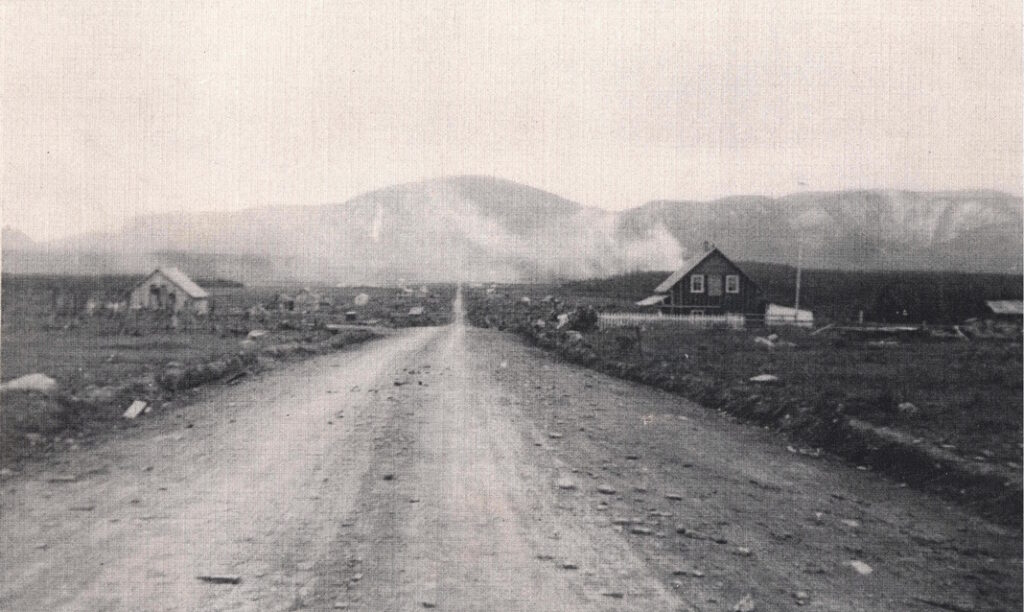The abandoned village of Saint-Octave-de-l’Avenir in Quebec, Canada, makes great inspiration for the site of a haunting in your campaign. A rural village near the mouth of the St. Lawrence River, its declining, aging population led the government to forcibly resettle the village in the 1970s. Later, the area was opened to tourism. At your table, you could easily justify hauntings in the area, with the spirits of the old folks forced out tied so strongly to the land that they returned to it in death. They may even prey upon the nearby skiers!
Saint-Octave-de-l’Avenir was founded in 1935 in a middle-of-nowhere site on the Gaspé peninsula in eastern Quebec. The founding was part of a broader Depression-era ‘back to the land’ effort to settle central Gaspé. Saint-Octave-de-l’Avenir reached its maximum population six years later with 1,000 inhabitants. Its population plummeted by half in the next twenty years, and by 1970, numbered only 200.

(Note that the content of this next paragraph is based on the recollections of a single local, recorded in a book of Quebecois folklore. The truth might be very different.)
Because Saint-Octave-de-l’Avenir was so remote – and the weather so snowy – it cost the government a great deal of money to keep the road to the village open all winter. And because the village’s population was growing older and older, keeping the road open was vital. Otherwise, you couldn’t get an ambulance through when one of the old folks had an emergency.
So in 1970, a referendum was held, and the inhabitants of Saint-Octave-de-l’Avenir voted to shutter their village. Services were shut off and everyone who left the area got a lump sum and a small stipend to help them resettle. Not everyone agreed to go. A handful of families stayed on for years. Folks barricaded themselves in their homes rather than let government workers resettle them off. They couldn’t bear to leave the land they’d worked their entire lives, the land many of them were born on.
Some of the houses were torn down. Others were burned. According to one, likely unreliable, account, a woman and her baby had hidden in one of the houses to keep from being forced out, and were burned alive.
Today, the abandoned site lies along a back entrance to a national park in the interior of the Gaspé peninsula. Every winter, skiers and snowshoers swarm to the area to enjoy the same deep snowfalls that supposedly drove the government to relocate the villagers. A hotel sits at the center of the village, across the street from an abandoned church. And the government keeps the roads open.
An adventure site based on Saint-Octave-de-l’Avenir would work well in almost any setting, but particularly well in science fiction, since games like Shadowrun and Firefly feature such strong themes of suspicion of government power. But it can absolutely work in any game where the PCs sometimes have cause to be suspicious of their governments.
What about the referendum? In real life, 90% of the villagers voted to close their own village. Of course, if you do away with the referendum, no one will blink twice, particularly in a fantasy setting where players expect a heavy-handed style of local rule. But keeping the referendum could be fun. Some PCs might see it as the tyranny of the majority, with the 90% of villagers who wanted to leave, cutting services to the 10% who wanted to stay. Others might see the referendum as proof that those who stayed behind are batty old codgers who don’t represent the sensible majority position.
And, of course, there’s no reason to limit yourself to snow as the reason for shutting down the village. Bandit raids, monster attacks, a perilous asteroid belt, or simple expense of resupply all might make sense, depending on your setting. Pick something that reinforces what makes your game unique.
So what kinds of adventures might one have in a site based on Saint-Octave-de-l’Avenir? Ghost stories are the easiest to justify! There already exists a ghost story about the burned lady and her baby. And no one would question the idea that old folks from Saint-Octave-de-l’Avenir who died elsewhere after resettlement might be drawn back to the soil to which they were so strongly bound. The ghosts may even be preying on the nearby skiers – angry that the tourists’ presence renders the ghosts’ sacrifice pointless (nowadays, the road stays open).
Alternately, it could be the site of government secrets! After the village was closed, the Canadian military opened a base nearby. The government might have known there was something in Saint-Octave-de-l’Avenir they wanted to keep hidden. So it’s a good place to stick your MacGuffin. The hotel across the street from the abandoned church could be staffed by government observers. Army scouts could disguise themselves as tourist skiers. And the folks who were resettled in the ’70s may know something useful!






